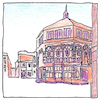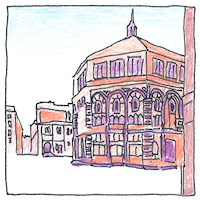Filippo Brunelleschi,
Leon Battista Alberti, Piero della Francesca
optics

|
Perspective
People in Florence had it figured out— how to trick the eye with an illusion of depth. Filippo Brunelleschi demonstrated its realism by comparing the view of the Florentine Baptistery from a doorway of the unfinished Il Duomo with his painting reflected in a mirror. Leon Battista Alberti wrote the first manual for artists. Piero della Francesca completed the picture by adding illustrations and showing how to represent solids in any area of the picture plane.
Other perspectives
Other artists had had other schemes. In ancient Egypt, major characters were larger and placed higher in the composition. In medieval illustrations, larger figures had more spiritual or social importance. Early Italian masters used shadowing to create an illusion of depth. In Byzantine art the settings of important figures were put in reverse perspective, where the vanishing point was in front of the picture.
Perspectives
Sitting at a dockside café with her, I seemed to think the sea stood upright like a blue wall. A small boat crawled slowly down like a snail with sails. As I raised a toast to the two of us, a jet passed overhead like the head of an arrow leaving a small hole in a cloud, like the hole in my heart. I waited for the evening’s wine to reverse the effects of my afternoon coffee, while the sun set and the sea disappeared under red flags, inverted, as though I were inside a camera obscura.



An artist expressing his or her feelings in art, even making abstract art, is an act of illusion, a sleight of hand. It is not a contradiction that a mathematics based on optics can help an artist create an illusion of a realistic scene. Our eyeballs project the world onto our retinas upside down and horizontally inverted. Given that our minds are not tied to the orientation of the image on our retinas, one might ask whether there is any limit to the mind’s ability to make things seem right when they are not.
Although Brunelleschi made his demonstration between 1413 and 1420, Alberti published De pictura in 1435, and Francesca wrote De Prospectiva Pingendi around 1480. It took many years for the practice to spread to other parts of Italy and Europe.
See also in The book of science:
Readings in wikipedia:
Other readings: